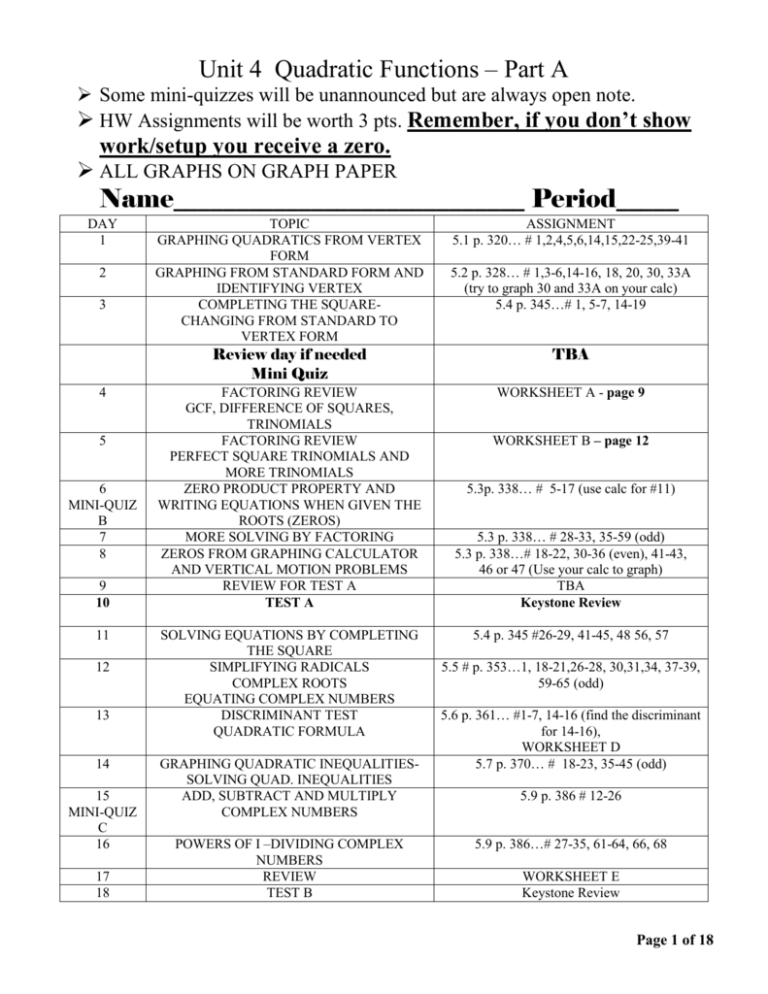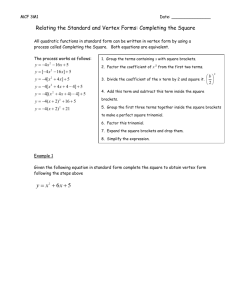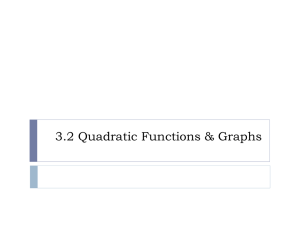ALGEBRA 2 X
advertisement

Unit 4 Quadratic Functions – Part A Some mini-quizzes will be unannounced but are always open note. HW Assignments will be worth 3 pts. Remember, if you don’t show work/setup you receive a zero. ALL GRAPHS ON GRAPH PAPER Name____________________________ Period_____ DAY 1 2 3 4 5 6 MINI-QUIZ B 7 8 9 10 11 12 13 14 15 MINI-QUIZ C 16 17 18 TOPIC GRAPHING QUADRATICS FROM VERTEX FORM GRAPHING FROM STANDARD FORM AND IDENTIFYING VERTEX COMPLETING THE SQUARECHANGING FROM STANDARD TO VERTEX FORM ASSIGNMENT 5.1 p. 320… # 1,2,4,5,6,14,15,22-25,39-41 5.2 p. 328… # 1,3-6,14-16, 18, 20, 30, 33A (try to graph 30 and 33A on your calc) 5.4 p. 345…# 1, 5-7, 14-19 Review day if needed Mini Quiz TBA FACTORING REVIEW GCF, DIFFERENCE OF SQUARES, TRINOMIALS FACTORING REVIEW PERFECT SQUARE TRINOMIALS AND MORE TRINOMIALS ZERO PRODUCT PROPERTY AND WRITING EQUATIONS WHEN GIVEN THE ROOTS (ZEROS) MORE SOLVING BY FACTORING ZEROS FROM GRAPHING CALCULATOR AND VERTICAL MOTION PROBLEMS REVIEW FOR TEST A TEST A WORKSHEET A - page 9 SOLVING EQUATIONS BY COMPLETING THE SQUARE SIMPLIFYING RADICALS COMPLEX ROOTS EQUATING COMPLEX NUMBERS DISCRIMINANT TEST QUADRATIC FORMULA GRAPHING QUADRATIC INEQUALITIESSOLVING QUAD. INEQUALITIES ADD, SUBTRACT AND MULTIPLY COMPLEX NUMBERS POWERS OF I –DIVIDING COMPLEX NUMBERS REVIEW TEST B WORKSHEET B – page 12 5.3p. 338… # 5-17 (use calc for #11) 5.3 p. 338… # 28-33, 35-59 (odd) 5.3 p. 338…# 18-22, 30-36 (even), 41-43, 46 or 47 (Use your calc to graph) TBA Keystone Review 5.4 p. 345 #26-29, 41-45, 48 56, 57 5.5 # p. 353…1, 18-21,26-28, 30,31,34, 37-39, 59-65 (odd) 5.6 p. 361… #1-7, 14-16 (find the discriminant for 14-16), WORKSHEET D 5.7 p. 370… # 18-23, 35-45 (odd) 5.9 p. 386 # 12-26 5.9 p. 386…# 27-35, 61-64, 66, 68 WORKSHEET E Keystone Review Page 1 of 18 U4 D1: Graphing Quadratics from Vertex Form 1. In unit 2, we looked at transformations Let’s explore TI Interactive! Quadratic Equation: y a x h k 2 a h k Vertex 2. Examples together: Let’s translate each parabola to find the vertex, then use the “a” value to graph! a) y x 2 3 b) y 3 x 1 4 1 c) y x 2 2 4 Vertex: _______ Vertex: _______ Vertex: _______ 2 2 Working backwards: You know the transformation, you have to write the equation. d) f x x2 is stretched vertically by 3 and translated left 2 e) f x x2 is reflected across the x-axis and translated 3 units up Page 2 of 18 The graph below illustrates the area of a room in a newly remodeled house. The “smaller” parabola was the original size, and the “larger” one represents the new size. Write the function of each parabola as a transformation of the function f ( x) x 2 . Next, write the function for the larger size as a transformation of the function of the original size. Function of Old Room: Function of New Room: Function of Old to New: Classwork: Mail merge! Page 3 of 18 U4 D2: Graphing from Standard Form & Identifying the Vertex 1. Yesterday we looked at quadratics in _________________ form. Ex: y 3 x 1 2 2 and the “stretch.” a. This is convenient because we can easily identify the vertex: 2. However, sometimes quadratics are written in ____________________ form: 3. To review “FOIL,” let’s convert y 3 x 1 2 into standard form. 2 4. From this form, we still want to be able to find the vertex (and other things)… Standard Form: Property y ax 2 bx c Example: y x2 2x 2 a positive a negative Max or Min? Vertex Axis of Symmetry y-intercept 5. How to graph f ( x) x 2 2 x 2 … Step 1: Plot the _________________ Step 2: Sketch the axis of symmetry. Step 3: Plot the _________________ Step 4: Use symmetry to find __________ Step 5: Sketch! Page 4 of 18 1) f ( x) 3x 2 2 x 1 2) f ( x) 2 x 2 4 x 2 Direction: _________________ Direction: _________________ Axis of Symmetry: _____________ Axis of Symmetry: _____________ Vertex: _______________ Vertex: _______________ Max or Min (and value): _________& __________ Max or Min (and value): _________& __________ y-intercept: ___________ y-intercept: ___________ WoRd: A record label uses the function a t 90t 2 8100t to model the sales of a new release. The number of albums sold is a function of time, t, in days. On which day were the most albums sold? What is the maximum number of albums sold on that day? WoRd AGaIn: A r WoRd AGaIN Page 5 of 18 U4 D3: Completing the Square: Change from Standard to Vertex 1. To start class yesterday, we converted the vertex form into standard form… y x 3 2 2 2. What if we had to work backwards? y x 2 10 x 13 . This is known as ________________________ the square. y x 2 10 x ______ 13 ______ Fill the blanks with _______________ Vertex is: _________________ 3. One more together: This time there is a number front of x 2 ( a 1 ). Factor it out!! f ( x) 3x 2 6 x 15 Factor: Add & Subtract: ___________ Vertex: ________________ Check: Page 6 of 18 Classwork Problems: Directions: Fill in the blank for each expression in order to complete the square. 1) x 2 4 x ______ 2) x 2 2 x ______ 3) x 2 8x ______ Directions: Write each function in vertex form, then identify its vertex. 1) f ( x) x 2 6 x 2 6) f ( x) 3x 2 12 x 4 5) f ( x) x 2 4 x 1 7) f ( x) 2 x 2 16 x 4 Closure: Vertex form: Vertex is: Standard form: Vertex is: To complete the square, add and subtract ___________________ to x 2 bx c . Page 7 of 18 U4 D4: Factoring Review – GCF, Diff of Squares, Trinomials Warmup: Following Mini Quiz A – factor the following! Remember, you can FOIL to check! 1) x 2 25 2) 3 x 2 12 x 3) x 2 9 x 14 4) x 2 2 x 48 5) x 2 9 6) 5 x 2 25 1. Factoring is the ____________________ process of expanding (multiplying through the distributive property, FOIL, etc). 2. Review: Distribute and FOIL a) 3x 4 x 7 b) x 5 x 6 3. Today we are going to tackle three types of factoring. 2 Terms 3 Terms GCF Difference of 2 Squares Guess and Check 2x 8 4 x 2 49 x 2 11x 30 3x3 15 x 2 a2 4 x 2 x 56 HW Start! Page 8 of 18 U4 D4: HW – WORKSHEET A Factor by removing a common factor: Check by distributing your answer: 1. 5 x 2 10 x 1. 2. 3 x 2 12 x 2. 3. 4 x 2 24 3. 4. 9 x 4 18 x 2 4. 5. 20 x 2 120 x 240 Factor using difference of squares, 2 2 a b (a b)(a b) : 5. Check by FOILing your answer: 6. 6. x 2 64 7. 7. x 2 121 8. 8. 9 x 2 25 9. 9. x 2 4 y 2 10. 10. ( x 4)2 9 Factor: Check by FOILing your answer: 11. x 2 x 30 11. 12. x 2 7 x 8 12. 13. x 2 12 x 20 13. 14. x 2 6 x 27 14. 15. x 2 10 x 24 15. Factor these various types: 18. x 2 25 16. x 2 10 x 16 19. 16 x 2 64 17. 7 x 3 49 x 20. 3x 2 6 x 45 Page 9 of 18 U4 D5: Factoring Review – Perfect Square Trinomials & British n 1 2 3 4 5 6 7 8 9 10 11 12 13 14 n2 What exponent does a variable have to have in order for it to be a perfect square? ________________! Perfect Square Trinomials x y _______________________ 2 Examples: x y 2 _______________________ 1) 9 x 2 30 x 25 2) x 2 14 x 49 3) 4 x 2 28 xy 49 y 2 4) 25 x 2 60 x 36 5) x 2 10 x 25 6) 4 x 2 12 x 9 The British Method! a) 2 x 2 7 x 15 Used when you have ________________________________. b) 10 x 2 13x 3 Page 10 of 18 Directions: Factor each expression, if possible. If not possible, write “not factorable” Page 11 of 18 U4 D5: HW – WORKSHEET B Factor these trinomial squares: Check by FOILing your answer: 1. x 2 6 x 9 1. 2. x 2 6 x 9 2. 3. x 2 16 x 64 3. 4. x 2 20 x 100 4. 5. 16 x 2 40 x 25 6. 9 x 2 6 xy y 2 5. 6. 7. 7. 4 x 16 x 16 2 8. 9 x 2 30 x 25 9. 16 x 2 48 xy 36 y 2 8. 9. 10. 10. 25 x 2 70 x 49 Factor: Check by FOILing your answer: 11. 2 x 2 13x 15 11. 12. 3x 2 5 x 2 12. 13. 4 x 2 12 x 5 13. 14. 21x 2 58 x 21 14. 15. 2 x 2 x 6 16. 6 x 2 10 x 4 15. 16. 17. 17. 4 x 14 x 6 2 18. 18. 2 x 11x 12 2 19. 10 x 13x 3 19. 2 20. 20. 15 x 2 16 x 15 Page 12 of 18 U4 D6: Zero Product Property & Writing Eq. when Given Roots 1. Reminder: The graph of a quadratic equation looks like a _______________. Today, we are interested in finding the place(s) where the graph crosses the ____________________. These values are known as the ______________________ or the ________________________ of the function (there is a slight difference, but we don’t need to worry about the technicality). Today’s Goals: 1) Given the equation, find the roots/zeros/solutions Zero _______________ Property: If x 1 x 5 0 , then… 2) Backwards Given the roots, write the equation Write as a product and _________________ it out! 2. Examples together: Find the zeros of each function by factoring a) f ( x) x 2 x 20 b) g ( x) 2 x 2 9 x 4 3. Examples together: Write a quadratic function in standard form for each given set of zeros. a) 6 and -3 b) -2 and 7 Classwork Activity (for the rest of today, and tomorrow)! Page 13 of 18 U4 D8: Zeros from Graphing Calculator and Vertical Motion 1) Yesterday (and probably last year, too!) you learned how to find the zeros of a quadratic function. Today we are going to look at a real world application of this: _________________ motion How hard you kick/throw/shoot the object from the beginning is 0 (disappears) when… Example #1: A soccer ball is kicked from the ground level with an initial velocity of 32 ft/s. After how many seconds will the ball hit the ground? Step 1: Write the general projectile function Step 2: Plug in anything you can Step 3: When does it mean for the ball to hit the ground? Answer: ____________________________! So, set … Calculator Notes: Page 14 of 18 Example #2: Marilyn hit a golf ball on the ground with her driver. Use the general function for a projectile to write a function that shows the height in feet of her golf ball as a function of time. The ball was hit with an initial vertical velocity of 100 feet per second. How long will Marilyn’s ball stay in the air? Example #3: A rocket is launched from the ground with an initial velocity of 144 ft/sec. (All work is to be done without using a calculator to graph. You may check your answers by graphing.) a. Write a function that represents this situation. b. At what time(s) will the rocket be 320 feet in the air? c. What is the maximum height of the rocket? How long does it take for the rocket to reach this height? d. When will the rocket hit the ground? Closure: What is the general projectile function? Explain each term. What is the function used for?! Page 15 of 18 U4 D9: Review for Unit 4 Test A Directions: Solve by factoring: 1) 3x 2 20 11x 2) x 2 9 x 36 0 3. Use completing the square to put this equation in vertex form. Then find the vertex. f ( x) x 2 8 x 3 Vertex form: f ( x) ___________________________ Vertex:_________________ For the problems below, make sure your answers are in the right format (point, line, number, etc.)! Find the information below then sketch the graph: 4. f ( x) ( x 1)2 5 which way does it open?_______________ Has a MAX or MIN?_______________ Vertex: _________________ Axis of Symmetry:_______________ Max / Min value:________________ Use the info to sketch the graph: Page 16 of 18 5. f ( x) x 2 6 x 5 which way does it open?_______________ Has a MAX or MIN?_______________ Vertex: _________________ Axis of Symmetry:_______________ Max / Min value:________________ Use the info to sketch the graph: 6. Here’s a graph…tell me the info: Which way does it open? Max / Min value: Has a MAX or MIN?_________ y-intercept:____________ Vertex: _________ x-intercepts:__________ Axis of Symmetry:________ Given that a = -1, write the equation in vertex form: __________________________ 7. Factor each of the following. a) 3x3 9 x 2 27 x 6 b) 2 x 2 x 6 _________________________ _____________________________ Page 17 of 18 c) 5 x 2 12 x 4 d) 4 x 2 20 x 25 __________________________ _______________________________ e) 81x 2 16 f) 3x 2 7 x 6 _____________________________ _____________________________ 8. For each problem below, you are given the roots of an equation. Find the factors, then write the equation in standard form. a) 3 and – 4 b) -17 and –5 ________________________ ____________________________ 9. Use your calculator to find the following information for the quadratic function f ( x) 4 x 2 8 x 5 . Vertex is________________ zeros are _________________ 10. The late great Mr. Rogers dropped a ball in the Land of Make Believe off the top of the castle that has a height of 50ft. a) Write a function that describes the position of the ball as a function of time. b) Determine when the ball hits the ground. Page 18 of 18








